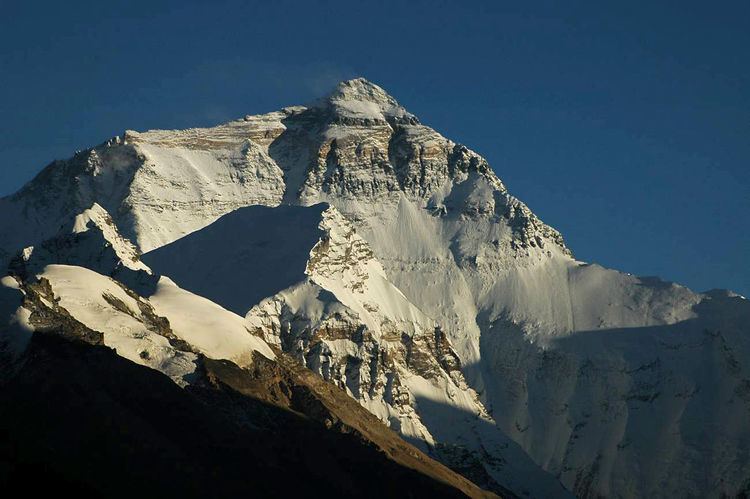 | ||
Mount Everest, at 8,848 metres (29,029 ft) is the world's highest mountain and a particularly desirable peak for mountaineers. Over 280 people have died trying to climb it and in the last few decades, fatalities have occurred every year. The last year without known fatalities on the mountain was 1977, a year in which only two people reached the summit.
Most deaths have been attributed to avalanches, injury from fall, ice collapse, exposure, or health problems related to conditions on the mountain. Not all bodies have been located, so details on those fatalities are not available.
The upper reaches of the mountain are in the death zone. The death zone is a mountaineering term for altitudes above a certain point – around 8,000 m (26,000 ft), or less than 356 millibars (5.16 psi) of atmospheric pressure – where the oxygen level is not sufficient to sustain human life. Many deaths in high-altitude mountaineering have been caused by the effects of the death zone, either directly (loss of vital functions) or indirectly (unwise decisions made under stress or physical weakening leading to accidents). In the death zone, the human body cannot acclimatize, as it uses oxygen faster than it can be replenished. An extended stay in the zone without supplementary oxygen will result in deterioration of bodily functions, loss of consciousness and, ultimately, death.
Background
The most popular routes are the South Col route from the Nepalese side and the North Col route from the Tibetan side.
The first recorded deaths on the mountain were the seven porters who perished in an avalanche in the 1922 British Mount Everest Expedition. George Mallory, who was present, blamed himself for the deaths. During the initial 1921 British Reconnaissance Expedition there were two deaths en route to the mountain – an unidentified porter as well as heart attack victim Dr. A. M. Kellas.
While dangerous for the novice climber, the mountain has also claimed the lives of some of the most experienced climbers. Babu Chiri Sherpa had climbed the mountain several times, and in 1999 spent 20 hours on the summit of Everest, then a new record. He also climbed to the summit twice in two weeks and held the record climbing time from Base Camp to summit of 16 hours and 56 minutes. He died in 2001 from a fall near Camp II. Experienced guide Rob Hall died on Everest shortly after becoming the first non-Sherpa to have summitted five times (1996).
One of the most infamous tragedies on the mountain was the 1996 Mount Everest disaster on May 11, 1996, during which eight people died while making summit attempts. In that entire season, 15 people died trying to reach the summit, making it the deadliest single year in the mountain's history to that point. The disaster gained wide publicity and has been written about many times; both Into Thin Air by Jon Krakauer and The Climb by Anatoli Boukreev were written by mountaineers who were on Mount Everest at the time, and they give conflicting accounts of the events. Curiously, 1996 was statistically a safe year for Everest climbers. Before 1996, one in four climbers had died making the ascent; 1996 saw huge numbers of people attempting the climb and the statistics for 1996 reveal that only one in seven died.
Another notable incident occurred in 1998 when Francys Arsentiev and her husband, Sergei Arsentiev, became separated and then died while looking for each other. Francys' frozen body lay next to the main route to the summit for nine years before climber Ian Woodall led an expedition to push her body over an edge and out of view.
In the consecutive 2014 and 2015 seasons, tragedies that each killed more than a dozen people caused no one to ascend the mountain in those years. On April 18, 2014, 16 Sherpas were killed in an avalanche that struck Base Camp. Just over a year later, on April 25, 2015, 19 people were killed in an avalanche at Base Camp following a powerful 7.8 earthquake, which killed at least 9,000 people and injured at least 23,000. This is the worst single-day death toll ever in the history of Mount Everest, in modern incidents with accurate counts.
Due to the difficulties and dangers in bringing bodies down, most of those who die on the mountain remain where they fall, although some are moved by winds and ice. Two Nepalese climbers died on October 24, 1984, while trying to recover the body of Hannelore Schmatz. While searching for George Mallory's body in a "catchment basin" near the peak in 1999, searchers came across multiple bodies in the snow, including Mallory's.
